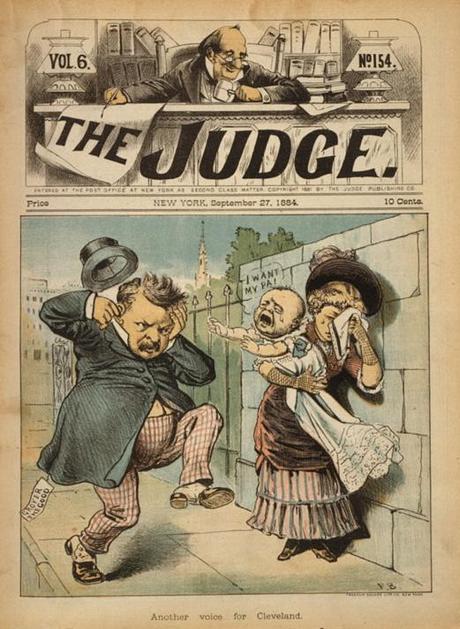
Cartoon mocking Grover Cleveland over the paternity scandal.
I cannot leave the subject of birthers without a quick visit to what I consider the strangest birth-related episode of all: the Grover Cleveland bastards.
Grover Cleveland hardly looks like a womanizer in his photographs -- conservative and dull in that Nineteenth Century way. Backers called him "Grover the Good," the reform-minded Buffalo mayor and New York governor who fought bosses and delivered scandal-free, competent leadership. "A public office is a public trust," would become his catch-phrase. "1. He is an honest man. 2. He is an honest man. 3. He is an honest man. 4. He is an honest man." Those are the four reasons the New York World gave in supporting him for president in 1884 when Cleveland won the Democratic nomination.
Running against Cleveland in 1884 was Republican James Gillespie Blaine, known to enemies as "the Continental liar from the state of Maine." Blaine, who served as Speaker to the House in the 1870s and Secretary of State under assassinated president James A. Garfield, had aggressively sought the presidency twice before, in 1876 and 1880, but failed both times largely over hints of corruption. In addition to Blaine's history as a patronage boss, a disclosure of secret letters from Blaine's congressional office ( the Mulligan Letters) suggested shady dealings with the Little Rock and Fort Smith Railroad for which Blaine allegedly received pay-offs of some $110,000 (about $2.5 million in modern money.)

Grover Cleveland -- Does he look like
a womanizer to you?
Blaine loudly denied wrong-doing, but the reputation stuck. One secret letter inspired a favorite campaign song for 1884:
"Burn, burn, burn this letter; "Kind regards to Mrs. Fisher."
The scandal even triggered a formal walkout by reform-minded Republicans, who left to form the Mugwumps and vote for Cleveland.
But then, one day in July 1884, things got turned upside down. The Buffalo Evening Telegram ran a front-page item titled "A Terrible Tale" that suddenly painted Grover the Good in a new light. The story told how Cleveland, as a young lawyer in Buffalo, had once met a widow named Maria Halpin. They had a liaison and produced a son, later named Osacar Folsom Cleveland. Cleveland refused to marry Ms. Halpin, though he provided for her and the son, even giving the boy his name. There were also charges that he tried to silence her, have her institutionalized, and that this was part of a larger pattern of drinking and carousing by Cleveland.
Republicans had a field day with the scandal. Finally, they had a weapon to take Grover the Good and knock him down a few notches. Cartoons like "Ma! Ma! Where's my Pa" (see above) appeared far and wide. Newspapers called Cleveland a "moral leper" and worse.
But Grover Cleveland, to his credit, recognized in this crisis that both good politics and good virtue demanded the same response. He had cast himself an honest reformer, and he needed to stick with his brand. "Above all, telll the truth," he told his troops. Rather than deny the charge, he admitted it (or at least much of it), disputed the overblown parts, and moved on.
The approach worked remarkably well. Rather than cripple his campaign, the scandal seemed to give it new energy. Cleveland's friends happily now cast the choice as between Blaine's corruption and Cleveland's honesty. Blaine was "whoring for votes," as the Reverend Henry Ward Beecher put it.
The mud-slinging didn't stop here. A few weeks later, the Indiana Sentinel (which backed Cleveland) came out with a story claiming that Blaine too had fathered a son out of wedlock -- based on the fact that Blaine's oldest son was born just three months after his Blanie's 1851 marriage to Harriet Stanwood. Blaine responded with a lawsuit, but the story grew murky over counterclaims that Blaine actually had married his wife twice -- the first time in secret -- thereby explaining the discrepancy in dates.
In the end, Grover Cleveland won the election in a squeaker, tipped in the final hours by the famous "Rum, Romanism and Rebellion" remark by a Blaine supporter that infuriated Inrish voters. But the birther issue of 1884 -- all those bastard children -- left a legacy. Among historians, 1884 is widely considered the dirtiest campaign in American history.
Lesson for Obama
What all these birther-type episodes have in common is this: The truth or falsity of the claim is beside the point. More important is the maliciousness behind it.
For instance, a perfectly legitimate question arose in 1880 when Republicans nominated Chester Alan Arthur for vice president, as to whether Arthur had been born in Northern Vermont or in nearby Canada -- which would disqualify him for the job. In the end, an investigation took place, and Arthur's actual place of birth was never proven to an absolute certainty -- that apparent standard today. Still, the lack of any credible evidence that it was not Vermont, as Arthur said it was, caused reasonable people to drop the issue.
Whether today's birthers are driven by healthy skepticism, racism, opportunism, panaroia, or some sociopathic condition, the problem -- particularly in the face of the latest evidence produced by the White House -- is that the malice, the desire to destroy Obama, appears way more important to them than the issue.
I'm all for good conspiracy theories. But I have a problem with pointless character assassination. Yes, there's a difference. Grow up, Donald Trump.
Here's a link to the best book about the 1884 campaign:

